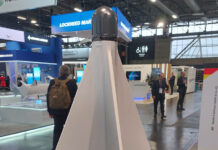Originally known as ‘bomb jammers’ these devices were utilized by EOD/ bomb disposal teams, to deny an adversary to trigger a device under inspection by the EOD technician. These jammers are also used by first responders when arriving at terror scenes, in effort to deny the activation of secondary explosive charges planted at the site, aimed against the rescue teams.
The IED jammer effectively cuts off radio communications from the triggering transmitter to the device attached to the bomb, thus temporarily preventing bomb detonation while the jammer is in effective range. At Milipol 2009, several Israeli companies are displaying advanced high-power jammers, among them devices designed for EOD and VIP applications.
Each member of the Netline’s C-Guard Very High Power IED jammers consists of multiple high-power transmitting devices, operating on different frequency bands, protecting personnel, vehicles and installations against complex threats, employing multiple threats operating over a wide area and broad frequency spectrum. To extend Radio Controlled Improvised Explosive Device (RCIED) protection, provided by the vehicular jammer to dismounted teams, Netline developed the C-Guard manpack. This system is designed as a lightweight, backpack system, to be operated by ground troops under risk of encountering remote controlled improvised explosive devices, including combat engineers, dismounted patrols etc. The battery powered system is blanketing a given area to prevent radio receivers from achieving RF signal for detonation of remote controlled explosive weapons. The system can be configured to cover VHF, UHF, cellphones and wireless devices, satellite phones etc.
To support bomb disposal units, a portable, battery-powered IED Jamming-device, such as the Netline TXP ECM can be employed. The system is housed in a trolley-style pelican case can be configured to operate on nearby AC main power or from an integral battery. These devices can be deployed to locations where the anti-IED vehicle has no access. Blocking multiple frequency bands in one case, the system covers a wide spectrum, from VHF to cell phones, satellite phones and beyond. The system can support extended and continuous field operations, by employing ‘hot swap’ of spare batteries.
















